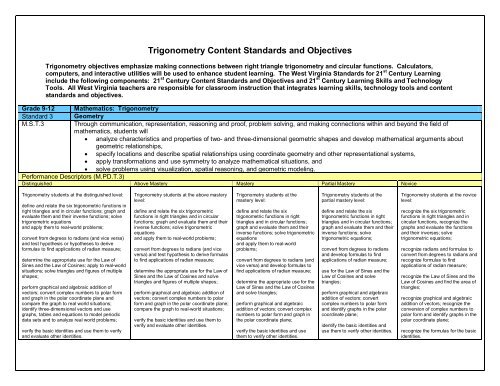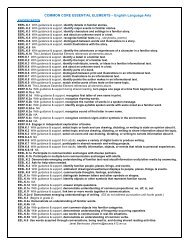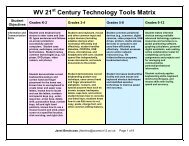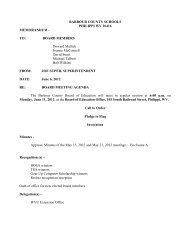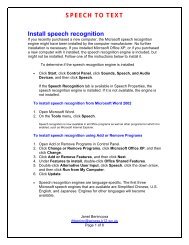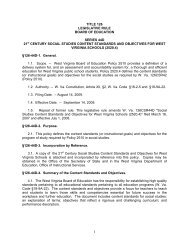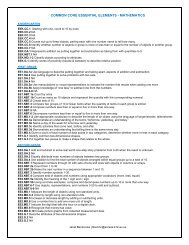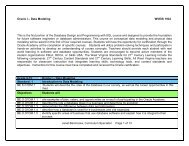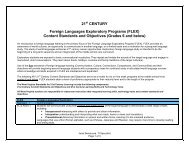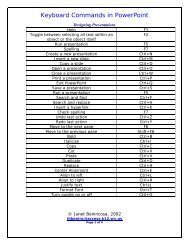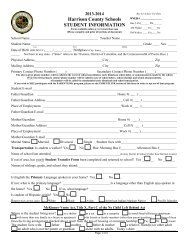Trigonometry Content Standards and Objectives - West Virginia ...
Trigonometry Content Standards and Objectives - West Virginia ...
Trigonometry Content Standards and Objectives - West Virginia ...
You also want an ePaper? Increase the reach of your titles
YUMPU automatically turns print PDFs into web optimized ePapers that Google loves.
Grade 9-12<br />
St<strong>and</strong>ard 3<br />
M.S.T.3<br />
<strong>Trigonometry</strong> <strong>Content</strong> <strong>St<strong>and</strong>ards</strong> <strong>and</strong> <strong>Objectives</strong><br />
<strong>Trigonometry</strong> objectives emphasize making connections between right triangle trigonometry <strong>and</strong> circular functions. Calculators,<br />
computers, <strong>and</strong> interactive utilities will be used to enhance student learning. The <strong>West</strong> <strong>Virginia</strong> <strong>St<strong>and</strong>ards</strong> for 21 st Century Learning<br />
include the following components: 21 st Century <strong>Content</strong> <strong>St<strong>and</strong>ards</strong> <strong>and</strong> <strong>Objectives</strong> <strong>and</strong> 21 st Century Learning Skills <strong>and</strong> Technology<br />
Tools. All <strong>West</strong> <strong>Virginia</strong> teachers are responsible for classroom instruction that integrates learning skills, technology tools <strong>and</strong> content<br />
st<strong>and</strong>ards <strong>and</strong> objectives.<br />
Mathematics: <strong>Trigonometry</strong><br />
Geometry<br />
Through communication, representation, reasoning <strong>and</strong> proof, problem solving, <strong>and</strong> making connections within <strong>and</strong> beyond the field of<br />
mathematics, students will<br />
• analyze characteristics <strong>and</strong> properties of two- <strong>and</strong> three-dimensional geometric shapes <strong>and</strong> develop mathematical arguments about<br />
geometric relationships,<br />
• specify locations <strong>and</strong> describe spatial relationships using coordinate geometry <strong>and</strong> other representational systems,<br />
• apply transformations <strong>and</strong> use symmetry to analyze mathematical situations, <strong>and</strong><br />
• solve problems using visualization, spatial reasoning, <strong>and</strong> geometric modeling.<br />
Performance Descriptors (M.PD.T.3)<br />
Distinguished Above Mastery Mastery Partial Mastery Novice<br />
<strong>Trigonometry</strong> students at the distinguished level:<br />
define <strong>and</strong> relate the six trigonometric functions in<br />
right triangles <strong>and</strong> in circular functions; graph <strong>and</strong><br />
evaluate them <strong>and</strong> their inverse functions; solve<br />
trigonometric equations<br />
<strong>and</strong> apply them to real-world problems;<br />
convert from degrees to radians (<strong>and</strong> vice versa)<br />
<strong>and</strong> test hypothesis or hypotheses to derive<br />
formulas to find applications of radian measure;<br />
determine the appropriate use for the Law of<br />
Sines <strong>and</strong> the Law of Cosines; apply to real-world<br />
situations; solve triangles <strong>and</strong> figures of multiple<br />
shapes;<br />
perform graphical <strong>and</strong> algebraic addition of<br />
vectors; convert complex numbers to polar form<br />
<strong>and</strong> graph in the polar coordinate plane <strong>and</strong><br />
compare the graph to real world situations;<br />
identify three-dimensional vectors <strong>and</strong> use<br />
graphs, tables <strong>and</strong> equations to model periodic<br />
data sets <strong>and</strong> to analyze real world problems;<br />
verify the basic identities <strong>and</strong> use them to verify<br />
<strong>and</strong> evaluate other identities.<br />
<strong>Trigonometry</strong> students at the above mastery<br />
level:<br />
define <strong>and</strong> relate the six trigonometric<br />
functions in right triangles <strong>and</strong> in circular<br />
functions; graph <strong>and</strong> evaluate them <strong>and</strong> their<br />
inverse functions; solve trigonometric<br />
equations<br />
<strong>and</strong> apply them to real-world problems;<br />
convert from degrees to radians (<strong>and</strong> vice<br />
versa) <strong>and</strong> test hypothesis to derive formulas<br />
to find applications of radian measure;<br />
determine the appropriate use for the Law of<br />
Sines <strong>and</strong> the Law of Cosines <strong>and</strong> solve<br />
triangles <strong>and</strong> figures of multiple shapes;<br />
perform graphical <strong>and</strong> algebraic addition of<br />
vectors; convert complex numbers to polar<br />
form <strong>and</strong> graph in the polar coordinate plane;<br />
compare the graph to real-world situations;<br />
verify the basic identities <strong>and</strong> use them to<br />
verify <strong>and</strong> evaluate other identities.<br />
<strong>Trigonometry</strong> students at the<br />
mastery level:<br />
define <strong>and</strong> relate the six<br />
trigonometric functions in right<br />
triangles <strong>and</strong> in circular functions;<br />
graph <strong>and</strong> evaluate them <strong>and</strong> their<br />
inverse functions; solve trigonometric<br />
equations<br />
<strong>and</strong> apply them to real-world<br />
problems;<br />
convert from degrees to radians (<strong>and</strong><br />
vice versa) <strong>and</strong> develop formulas to<br />
find applications of radian measure;<br />
determine the appropriate use for the<br />
Law of Sines <strong>and</strong> the Law of Cosines<br />
<strong>and</strong> solve triangles;<br />
perform graphical <strong>and</strong> algebraic<br />
addition of vectors; convert complex<br />
numbers to polar form <strong>and</strong> graph in<br />
the polar coordinate plane;<br />
verify the basic identities <strong>and</strong> use<br />
them to verify other identities.<br />
<strong>Trigonometry</strong> students at the<br />
partial mastery level:<br />
define <strong>and</strong> relate the six<br />
trigonometric functions in right<br />
triangles <strong>and</strong> in circular functions;<br />
graph <strong>and</strong> evaluate them <strong>and</strong> their<br />
inverse functions; solve<br />
trigonometric equations;<br />
convert from degrees to radians<br />
<strong>and</strong> develop formulas to find<br />
applications of radian measure;<br />
use for the Law of Sines <strong>and</strong> the<br />
Law of Cosines <strong>and</strong> solve<br />
triangles;<br />
perform graphical <strong>and</strong> algebraic<br />
addition of vectors; convert<br />
complex numbers to polar form<br />
<strong>and</strong> identify graphs in the polar<br />
coordinate plane;<br />
identify the basic identities <strong>and</strong><br />
use them to verify other identities.<br />
<strong>Trigonometry</strong> students at the novice<br />
level:<br />
recognize the six trigonometric<br />
functions in right triangles <strong>and</strong> in<br />
circular functions, recognize the<br />
graphs <strong>and</strong> evaluate the functions<br />
<strong>and</strong> their inverses; solve<br />
trigonometric equations;<br />
recognize radians <strong>and</strong> formulas to<br />
convert from degrees to radians <strong>and</strong><br />
recognize formulas to find<br />
applications of radian measure;<br />
recognize the Law of Sines <strong>and</strong> the<br />
Law of Cosines <strong>and</strong> find the area of<br />
triangles;<br />
recognize graphical <strong>and</strong> algebraic<br />
addition of vectors; recognize the<br />
conversion of complex numbers to<br />
polar form <strong>and</strong> identify graphs in the<br />
polar coordinate plane;<br />
recognize the formulas for the basic<br />
identities.
<strong>Objectives</strong><br />
M.O.T.3.1<br />
M.O.T.3.2<br />
M.O.T.3.3<br />
M.O.T.3.4<br />
M.O.T.3.5<br />
M.O.T.3.6<br />
M.O.T.3.7<br />
M.O.T.3.8<br />
M.O.T.3.9<br />
M.O.T.3.10<br />
M.O.T.3.11<br />
Students will<br />
apply the right triangle definition of the six trigonometric functions of an angle to determine the values of the function values of an angle in<br />
st<strong>and</strong>ard position given a point on the terminal side of the angle.<br />
• determine the value of the other trigonometric functions given the value of one of the trigonometric functions <strong>and</strong> verify these values with<br />
technology.<br />
• using geometric principles <strong>and</strong> the Pythagorean Theorem, determine the six function values for the special angles <strong>and</strong> the quadrantal<br />
angles <strong>and</strong> use them in real-world problems.<br />
• compare circular functions <strong>and</strong> the trigonometric function values to draw inferences about coterminal angles <strong>and</strong> co-functions.<br />
convert angle measures from degrees to radians (<strong>and</strong> vice versa) <strong>and</strong> apply this concept to<br />
• create a data set, analyze, <strong>and</strong> formulate a hypotheses to test <strong>and</strong> develop formulas for the arclength, area of a sector, <strong>and</strong> angular<br />
velocity <strong>and</strong> use the formula for application in the real-world.<br />
• compare <strong>and</strong> contrast the concepts of angular velocity <strong>and</strong> linear velocity <strong>and</strong> demonstrate by graphical or algebraic means relationship<br />
between them <strong>and</strong> apply to real-world problems.<br />
using various methods, basic identities <strong>and</strong> graphical representation<br />
• verify trigonometric identities<br />
• prove the sum <strong>and</strong> difference to two angles, double-angles, <strong>and</strong> half-angle identities<br />
justify <strong>and</strong> present the solutions of trigonometric equations that include both infinite <strong>and</strong> finite (over a restricted domain) solutions.<br />
find the value of the inverse trigonometric functions using special angle trigonometric function values <strong>and</strong> technology.<br />
• draw inferences of restricted domain to recognize <strong>and</strong> produce a graph of the inverse trigonometric functions.<br />
• prove conjectures made about the solution of the equations such as x = sin (arcsin y), x = sin (arcos y) being sure to consider restrictions<br />
of the domain.<br />
identify a real life problem utilizing graphs of trigonometric functions <strong>and</strong>/or the inverse functions; make a hypothesis as to the outcome; develop,<br />
justify, <strong>and</strong> implement a method to collect, organize, <strong>and</strong> analyze data; generalize the results to make a conclusion; compare the hypothesis <strong>and</strong><br />
the conclusion; present the project using words, graphs, drawings, models, or tables.<br />
model periodic data sets using graphs, tables, <strong>and</strong> equations <strong>and</strong> use them to analyze real-world problems such as electricity <strong>and</strong> harmonic<br />
motion.<br />
investigate real-world problems within a project based investigation involving triangles using the trigonometric functions, the law of sines <strong>and</strong> the<br />
law of cosines, justify <strong>and</strong> present results.<br />
develop <strong>and</strong> test a hypothesis to find the area of a triangle given the measures of two sides <strong>and</strong> the included angle or the measures of three<br />
sides (Heron's formula) <strong>and</strong> use these formulas to find total area of figures constructed of multiple shapes.<br />
express complex numbers in polar form:<br />
• perform operations including adding, subtracting, multiplying, <strong>and</strong> dividing;<br />
• evaluate powers <strong>and</strong> roots of complex numbers using De Moivre's Theorem; <strong>and</strong> graph complex numbers.<br />
• graph complex numbers in the polar coordinate plane <strong>and</strong> make conjectures about some polar graphs <strong>and</strong> real-world situations<br />
such as the paths that the planets travel.<br />
create graphical <strong>and</strong> algebraic representations for performing vector operations <strong>and</strong> analyze these to solve real-world problems such as force<br />
analysis <strong>and</strong> navigation.


